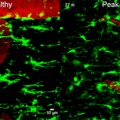
Ezekben a percekben az űrben
Van videó is Samantháról amint a pletizmográfot használja és Zambonival kommunikál az űrállomásról!
Itt alant angolul olvasható Samantha beszámolója arról, hogyan használja Zamboni pletizmográfját az agyból a szív felé áramló vér mérésére. A képen a nyakára csatolva látható az a fekete gallér-szerű műszer amit remélhetőleg hamarosan magyar kutatók is a CCSVI mérésére, kutatására fognak használni.
Early in the morning on Monday it was also time for the first session of Drain Brain. Actually, we already had an ultrasound session early on in the mission, but for this particular set of measurements we had to wait for the replacement hardware to be delivered on Dragon, following the loss of the Orbital-3 mission. Specific instruments for Drain Brain include three strain-gauge pletismoghraphs, which look like collars of a stretchable material, as you can see in the picture. They are actually sensors able to measure blood flow in the veins in a very simple and non-invasive manner, which is not dependent on the skills and interpretation of the operator, as is the case with ultrasound. While wearing these collars on my neck, arm and leg, I performed a series of breaths at 70% of my lung capacity, either remaining still or stretching and flexing my hand or my ankle. While doing that, I was breathing into our Pulmonary Function System and the software, via a graphic interface, was giving me instructions on when to start exhaling or inhaling. The main goal of the experiment is to study how the return of blood from the head to the heart changes in space, since we don’t have gravity effects helping with that. It’s something that we know little about for now and a better understanding of these circulatory mechanisms could potentially help in understanding some degenerative diseases of the brain. - Samantha Cristoforetti forrás
Mindeközben a Földön:
Az új technológiák által az SM kutatók sejtszinten tudják vizsgálni az SM-es agyat, a gócok kialakulása ELŐTT. A következőkben három különösen fontos kutatást ismertetünk röviden.
A sejtbiológusok a legalacsonyabb szinten vizsgálják az SM-es agyat, sejtszinten. Ők nem azt vizsgálják, hogy bizonyos gyógyszerek hogyan hatnak, hanem azt kutatják hogy mi lehet az SM okozója. És mindegyikük lát kapcsolatot az SM, az érrendszer és az vér-agy gát sérülése között.
A NASA szeretné megérteni, hogy az űrhajósainak a 20%-a miért érkezik vissza a világűrből neurológiai és látásproblémákkal, és hogy ennek mi köze a vérkeringéshez. Ezért szakértőhöz fordultak.
http://www.nasa.gov/mission_pages/station/research/experiments/1278.html
Íme a vadonatúj kutatási eredmények, mind az SM és az érrendszer kapcsolatát erősítik. Az összefoglalókat angolul közlöm, mert sajnos nem látom értelmét magyarra fordítani - olyan kevesen érdeklődnek hazánkban eziránt a kutatási irány iránt. Szeretném hinni, hogy van akit érdekelnek az új kutatások és van aki még azt gondolja, hogy nem szabad kivárni azt a 20 évet, ami alatt ez a tudás mainstream tudássá változik, hanem kutatni kell és menni előre.
Elvégre is emberéletekről beszélünk.
1. The Role of Angiogenesis in the Pathology of MS
http://www.ncbi.nlm.nih.gov/pmc/articles/PMC4253611/
Cell biologists from the University of Irvine have noted how the loss of endothelial tight junctions in the blood brain barrier contributes to inflammation and angiogenesis (the growth of new blood vessels) in the MS brain, and how this process is initiated by hypoxia. This low oxygen state and resultant angiogenesis occurs prior to formation of demyelinating lesions.
This cellular research is further defining the hypothesis of cellular biologist Dr. Bernhard Juurlink, made in the 1990s.
http://ccsviinms.blogspot.com/2010/08/blood-flow-and-white-matter-lesions.html
It also fits in with the hypothesis of MS as a disease of hypoperfusion/reperfusion injury.
http://ccsviinms.blogspot.com/2013/09/multiple-sclerosis-hypoperfusionreperfu.html
2. In vitro study of the direct effect of extracellular hemoglobin on myelin components.
http://www.ncbi.nlm.nih.gov/pubmed/25463632
The cellular biologists from the University of Guelph are looking at how blood particles damage myelin. They are seeing microscopic deposits of hemoglobin in the MS brain, around the veins. This blood contains iron, which when deposited into delicate brain tissue, begins a process of oxidative stress.
http://ccsvi.org/index.php/helping-myself/endothelial-health
Joan Beal cikke alapján



